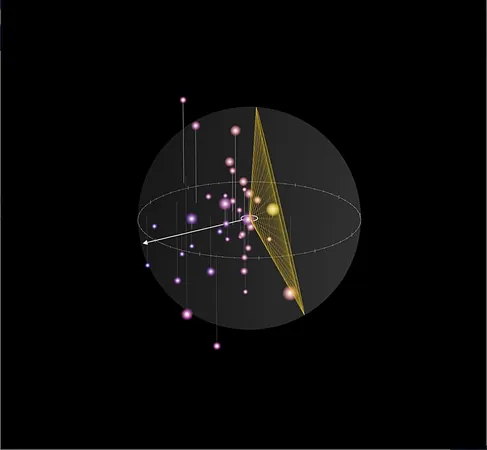
Andromeda's Dwarf Galaxies: A Shocking Asymmetry That Challenges Our Universe's Rules
2025-04-11
Author: Li
A Galactic Puzzle: Andromeda's Mysterious Dwarf Companions
The Andromeda galaxy, our nearest galactic neighbor, is home to a cluster of dwarf galaxies that defy the usual cosmic patterns. Recent findings published in Nature Astronomy reveal that the arrangement of these companions is not only unusual, but ranks among the rarest configurations found in the universe—only 0.3% of similar systems exhibit such lopsidedness.
Astronomers have long relied on the spatial distribution of galaxies to understand the cosmos and the elusive nature of dark matter. Traditionally, smaller galaxies are expected to merge chaotically over time, resulting in a scattering of faint dwarf galaxies around more massive hosts. However, recent research from the Leibniz Institute for Astrophysics Potsdam (AIP) is shaking up this paradigm.
An Unexpected Arrangement: Andromeda's Dwarfs Cluster to One Side
Rather than the random distribution expected, a staggering 80% of Andromeda's dwarf galaxies are gathered on one side. A new dataset analyzing the distances of 37 satellite galaxies has made this striking pattern clear. Almost all of these satellites are located within a narrow arc of just 107 degrees pointing towards our Milky Way, covering only 64% of Andromeda's entire vicinity.
"This asymmetry is not only surprising but has only become clearer as more faint galaxies have been detected and their distances measured more accurately," states Kosuke Jamie Kanehisa, Ph.D. student at AIP and lead author of the study.
The Rare Cosmic Outlier: Andromeda's Position in the Universe
Modern simulations of galaxy evolution reveal a shocking truth: to find another galaxy system with a similar extreme asymmetry to Andromeda, astronomers must sift through over 300 models. Dr. Marcel S. Pawlowski from AIP emphasizes how unique this arrangement is, making Andromeda a standout in the cosmos—a true cosmic anomaly.
Adding to the intrigue, half of Andromeda’s satellites form a thin, disk-like structure, echoing the setup of our own solar system. This tandem of a flat satellite plane combined with the lopsided distribution is baffling within the framework of standard cosmological models.
What's Next? Hunting for Similarities in the Universe
These discoveries prompt profound questions: Is Andromeda's peculiar formation a unique incident or does it indicate gaps in our understanding of how galaxies form? Researchers are not stopping here; efforts are ramping up to explore distant galaxies for patterns that mirror Andromeda's unusual characteristics. Upcoming surveys like the Euclid spacecraft promise to provide further insights into these cosmic curiosities.
While these revelations challenge our current cosmic theories, the reliance on accurate simulations highlights the complexities involved in modeling stellar physics and galaxy evolution. As scientists delve deeper into Andromeda’s past mergers and unique characteristics, they hope to uncover whether such surprising asymmetries can naturally occur in a universe dominated by dark matter.



 Brasil (PT)
Brasil (PT)
 Canada (EN)
Canada (EN)
 Chile (ES)
Chile (ES)
 Česko (CS)
Česko (CS)
 대한민국 (KO)
대한민국 (KO)
 España (ES)
España (ES)
 France (FR)
France (FR)
 Hong Kong (EN)
Hong Kong (EN)
 Italia (IT)
Italia (IT)
 日本 (JA)
日本 (JA)
 Magyarország (HU)
Magyarország (HU)
 Norge (NO)
Norge (NO)
 Polska (PL)
Polska (PL)
 Schweiz (DE)
Schweiz (DE)
 Singapore (EN)
Singapore (EN)
 Sverige (SV)
Sverige (SV)
 Suomi (FI)
Suomi (FI)
 Türkiye (TR)
Türkiye (TR)
 الإمارات العربية المتحدة (AR)
الإمارات العربية المتحدة (AR)